Japan's Economic Analysis: Recent Developments and Future Priorities
VerifiedAdded on 2023/06/11
|11
|2757
|189
Report
AI Summary
This report provides an analysis of Japan's economy, focusing on recent developments and their impact on the global economy. It identifies key issues such as the shrinking population, the need for improved education and training, and the importance of foreign investment. The report discusses the potential boost from the 2020 Tokyo Olympics and the effects of increasing the retirement age. It also evaluates policies the Japanese government should prioritize over the next few years to address these challenges and foster economic growth, including structural reforms to encourage globalization and demographic shifts in hiring practices to reduce risks and promote innovation. The report concludes by emphasizing the need for Japan to embrace globalization and inward investment to enhance productivity and maintain economic stability.
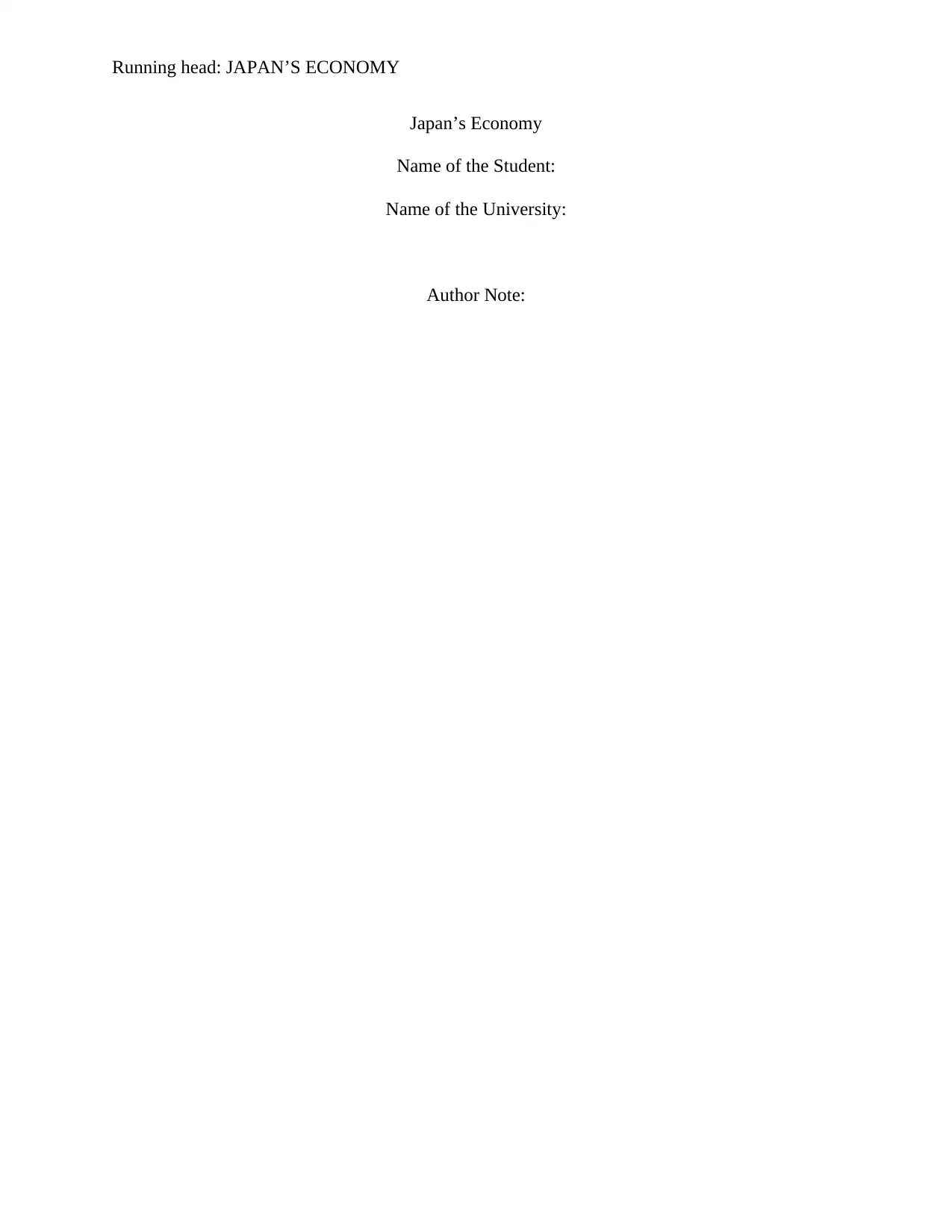
Running head: JAPAN’S ECONOMY
Japan’s Economy
Name of the Student:
Name of the University:
Author Note:
Japan’s Economy
Name of the Student:
Name of the University:
Author Note:
Paraphrase This Document
Need a fresh take? Get an instant paraphrase of this document with our AI Paraphraser
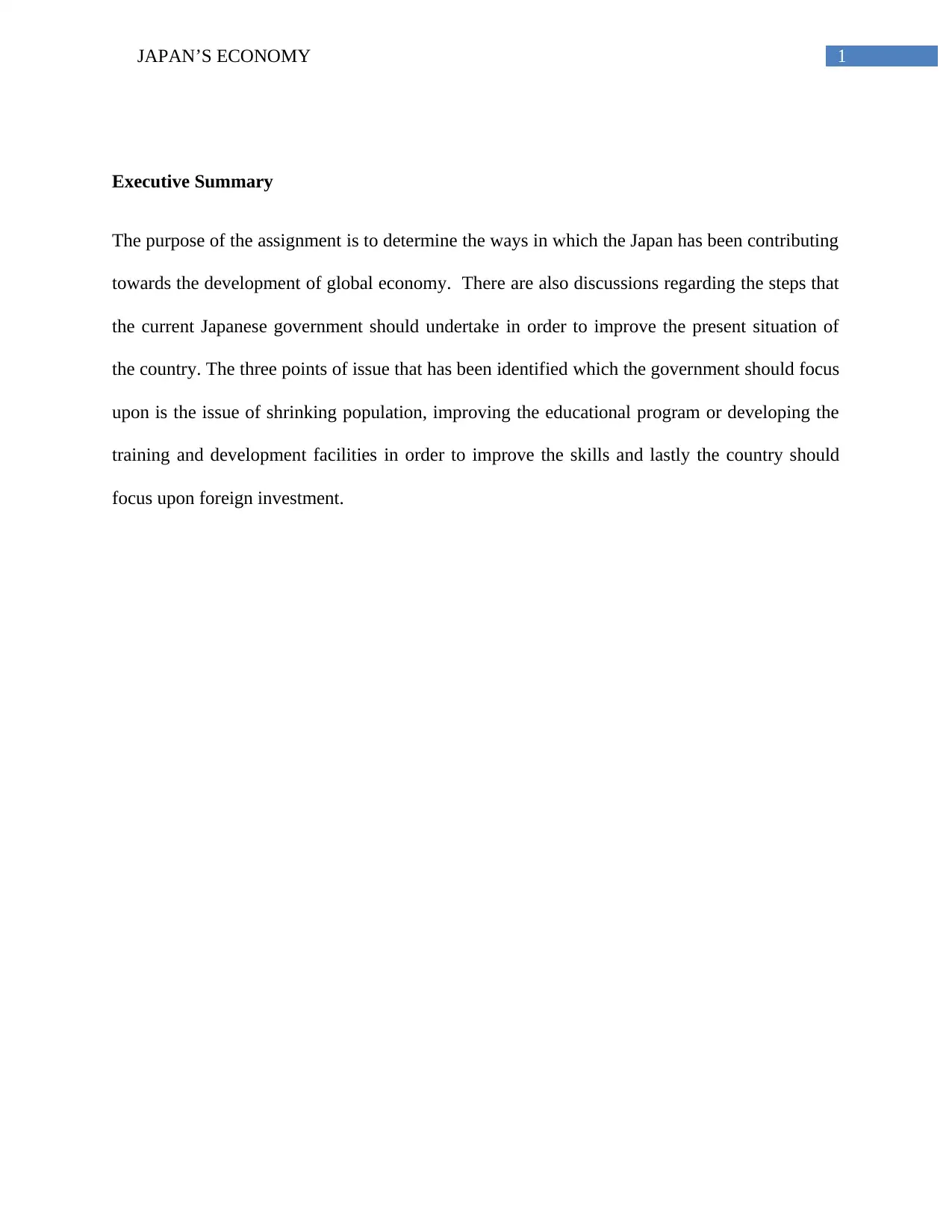
1JAPAN’S ECONOMY
Executive Summary
The purpose of the assignment is to determine the ways in which the Japan has been contributing
towards the development of global economy. There are also discussions regarding the steps that
the current Japanese government should undertake in order to improve the present situation of
the country. The three points of issue that has been identified which the government should focus
upon is the issue of shrinking population, improving the educational program or developing the
training and development facilities in order to improve the skills and lastly the country should
focus upon foreign investment.
Executive Summary
The purpose of the assignment is to determine the ways in which the Japan has been contributing
towards the development of global economy. There are also discussions regarding the steps that
the current Japanese government should undertake in order to improve the present situation of
the country. The three points of issue that has been identified which the government should focus
upon is the issue of shrinking population, improving the educational program or developing the
training and development facilities in order to improve the skills and lastly the country should
focus upon foreign investment.
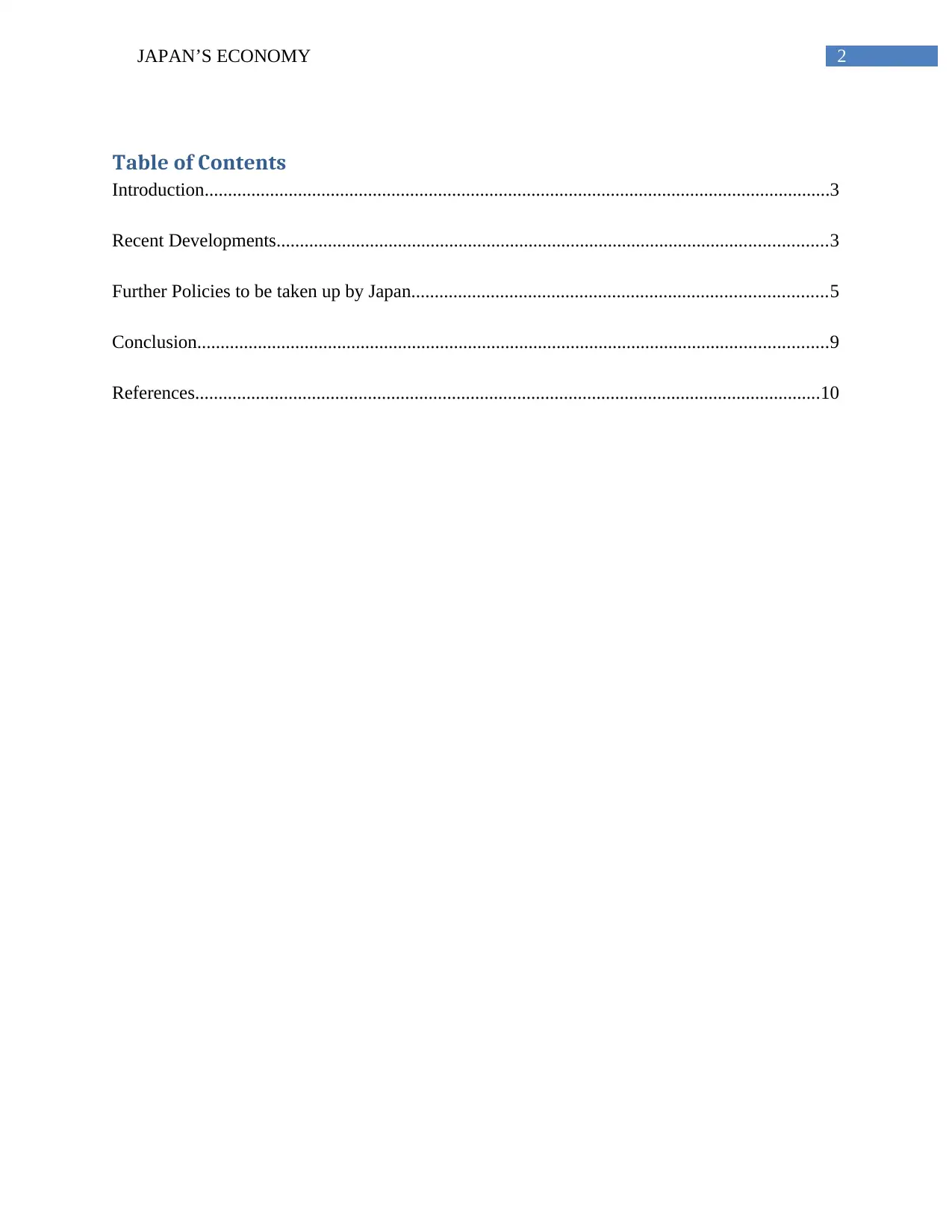
2JAPAN’S ECONOMY
Table of Contents
Introduction......................................................................................................................................3
Recent Developments......................................................................................................................3
Further Policies to be taken up by Japan.........................................................................................5
Conclusion.......................................................................................................................................9
References......................................................................................................................................10
Table of Contents
Introduction......................................................................................................................................3
Recent Developments......................................................................................................................3
Further Policies to be taken up by Japan.........................................................................................5
Conclusion.......................................................................................................................................9
References......................................................................................................................................10
⊘ This is a preview!⊘
Do you want full access?
Subscribe today to unlock all pages.

Trusted by 1+ million students worldwide
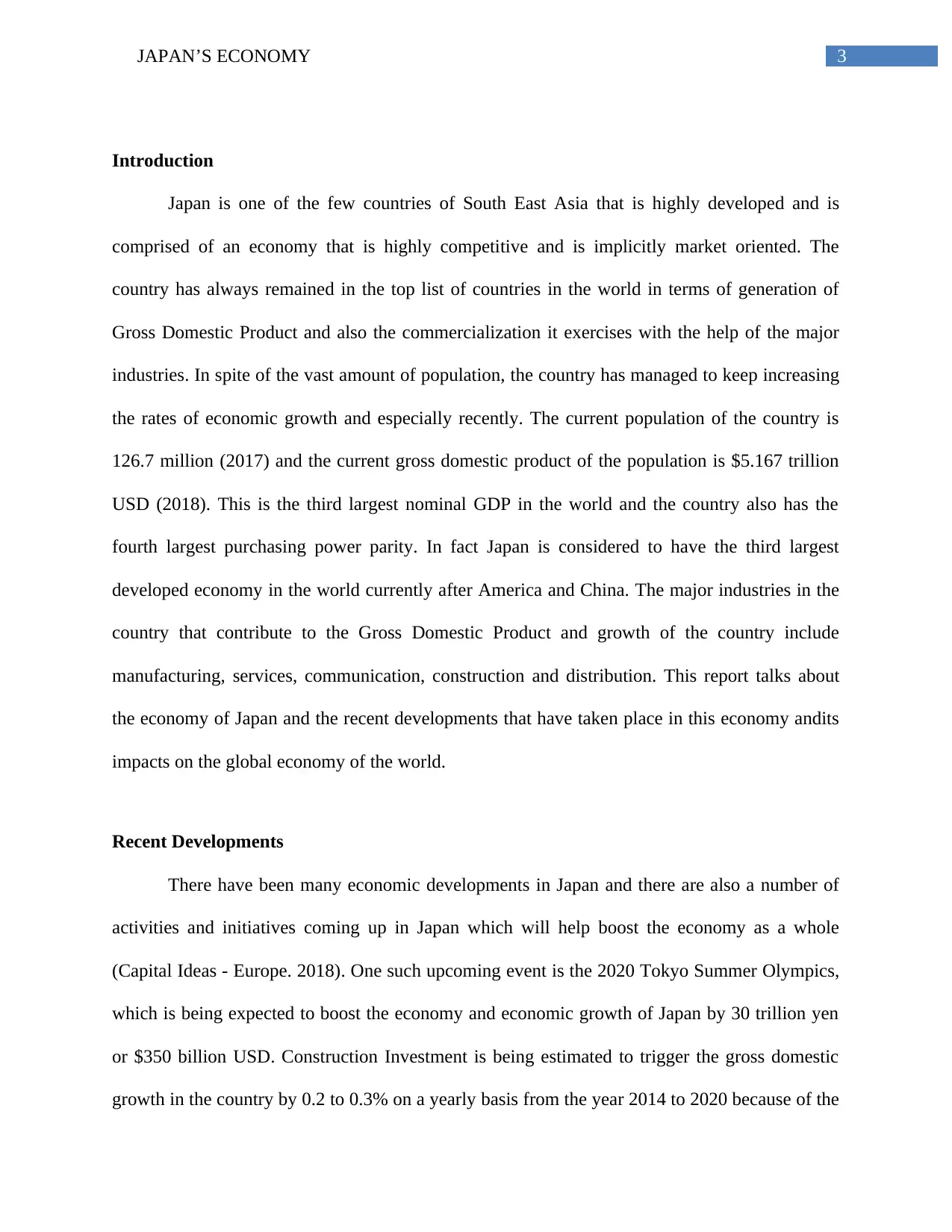
3JAPAN’S ECONOMY
Introduction
Japan is one of the few countries of South East Asia that is highly developed and is
comprised of an economy that is highly competitive and is implicitly market oriented. The
country has always remained in the top list of countries in the world in terms of generation of
Gross Domestic Product and also the commercialization it exercises with the help of the major
industries. In spite of the vast amount of population, the country has managed to keep increasing
the rates of economic growth and especially recently. The current population of the country is
126.7 million (2017) and the current gross domestic product of the population is $5.167 trillion
USD (2018). This is the third largest nominal GDP in the world and the country also has the
fourth largest purchasing power parity. In fact Japan is considered to have the third largest
developed economy in the world currently after America and China. The major industries in the
country that contribute to the Gross Domestic Product and growth of the country include
manufacturing, services, communication, construction and distribution. This report talks about
the economy of Japan and the recent developments that have taken place in this economy andits
impacts on the global economy of the world.
Recent Developments
There have been many economic developments in Japan and there are also a number of
activities and initiatives coming up in Japan which will help boost the economy as a whole
(Capital Ideas - Europe. 2018). One such upcoming event is the 2020 Tokyo Summer Olympics,
which is being expected to boost the economy and economic growth of Japan by 30 trillion yen
or $350 billion USD. Construction Investment is being estimated to trigger the gross domestic
growth in the country by 0.2 to 0.3% on a yearly basis from the year 2014 to 2020 because of the
Introduction
Japan is one of the few countries of South East Asia that is highly developed and is
comprised of an economy that is highly competitive and is implicitly market oriented. The
country has always remained in the top list of countries in the world in terms of generation of
Gross Domestic Product and also the commercialization it exercises with the help of the major
industries. In spite of the vast amount of population, the country has managed to keep increasing
the rates of economic growth and especially recently. The current population of the country is
126.7 million (2017) and the current gross domestic product of the population is $5.167 trillion
USD (2018). This is the third largest nominal GDP in the world and the country also has the
fourth largest purchasing power parity. In fact Japan is considered to have the third largest
developed economy in the world currently after America and China. The major industries in the
country that contribute to the Gross Domestic Product and growth of the country include
manufacturing, services, communication, construction and distribution. This report talks about
the economy of Japan and the recent developments that have taken place in this economy andits
impacts on the global economy of the world.
Recent Developments
There have been many economic developments in Japan and there are also a number of
activities and initiatives coming up in Japan which will help boost the economy as a whole
(Capital Ideas - Europe. 2018). One such upcoming event is the 2020 Tokyo Summer Olympics,
which is being expected to boost the economy and economic growth of Japan by 30 trillion yen
or $350 billion USD. Construction Investment is being estimated to trigger the gross domestic
growth in the country by 0.2 to 0.3% on a yearly basis from the year 2014 to 2020 because of the
Paraphrase This Document
Need a fresh take? Get an instant paraphrase of this document with our AI Paraphraser
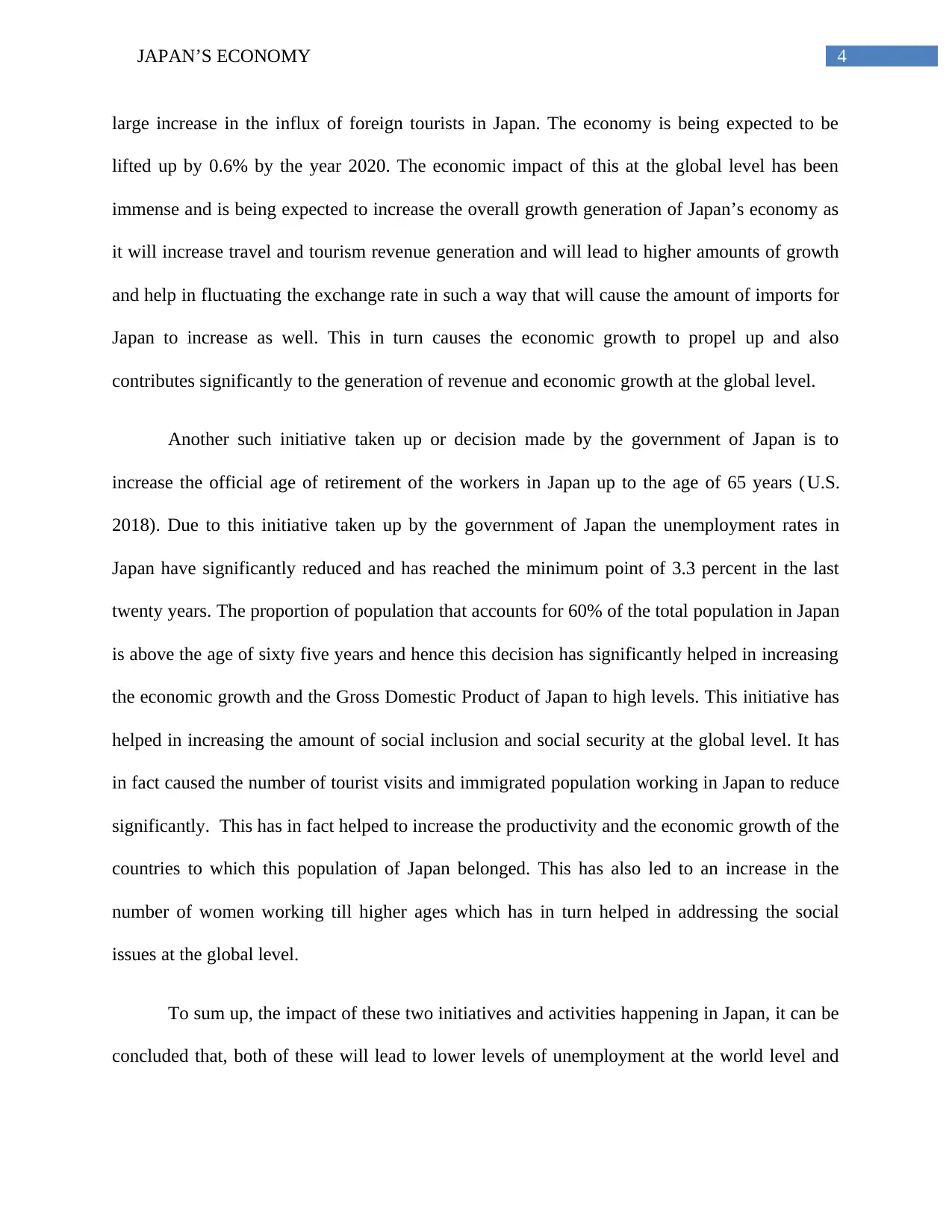
4JAPAN’S ECONOMY
large increase in the influx of foreign tourists in Japan. The economy is being expected to be
lifted up by 0.6% by the year 2020. The economic impact of this at the global level has been
immense and is being expected to increase the overall growth generation of Japan’s economy as
it will increase travel and tourism revenue generation and will lead to higher amounts of growth
and help in fluctuating the exchange rate in such a way that will cause the amount of imports for
Japan to increase as well. This in turn causes the economic growth to propel up and also
contributes significantly to the generation of revenue and economic growth at the global level.
Another such initiative taken up or decision made by the government of Japan is to
increase the official age of retirement of the workers in Japan up to the age of 65 years ( U.S.
2018). Due to this initiative taken up by the government of Japan the unemployment rates in
Japan have significantly reduced and has reached the minimum point of 3.3 percent in the last
twenty years. The proportion of population that accounts for 60% of the total population in Japan
is above the age of sixty five years and hence this decision has significantly helped in increasing
the economic growth and the Gross Domestic Product of Japan to high levels. This initiative has
helped in increasing the amount of social inclusion and social security at the global level. It has
in fact caused the number of tourist visits and immigrated population working in Japan to reduce
significantly. This has in fact helped to increase the productivity and the economic growth of the
countries to which this population of Japan belonged. This has also led to an increase in the
number of women working till higher ages which has in turn helped in addressing the social
issues at the global level.
To sum up, the impact of these two initiatives and activities happening in Japan, it can be
concluded that, both of these will lead to lower levels of unemployment at the world level and
large increase in the influx of foreign tourists in Japan. The economy is being expected to be
lifted up by 0.6% by the year 2020. The economic impact of this at the global level has been
immense and is being expected to increase the overall growth generation of Japan’s economy as
it will increase travel and tourism revenue generation and will lead to higher amounts of growth
and help in fluctuating the exchange rate in such a way that will cause the amount of imports for
Japan to increase as well. This in turn causes the economic growth to propel up and also
contributes significantly to the generation of revenue and economic growth at the global level.
Another such initiative taken up or decision made by the government of Japan is to
increase the official age of retirement of the workers in Japan up to the age of 65 years ( U.S.
2018). Due to this initiative taken up by the government of Japan the unemployment rates in
Japan have significantly reduced and has reached the minimum point of 3.3 percent in the last
twenty years. The proportion of population that accounts for 60% of the total population in Japan
is above the age of sixty five years and hence this decision has significantly helped in increasing
the economic growth and the Gross Domestic Product of Japan to high levels. This initiative has
helped in increasing the amount of social inclusion and social security at the global level. It has
in fact caused the number of tourist visits and immigrated population working in Japan to reduce
significantly. This has in fact helped to increase the productivity and the economic growth of the
countries to which this population of Japan belonged. This has also led to an increase in the
number of women working till higher ages which has in turn helped in addressing the social
issues at the global level.
To sum up, the impact of these two initiatives and activities happening in Japan, it can be
concluded that, both of these will lead to lower levels of unemployment at the world level and
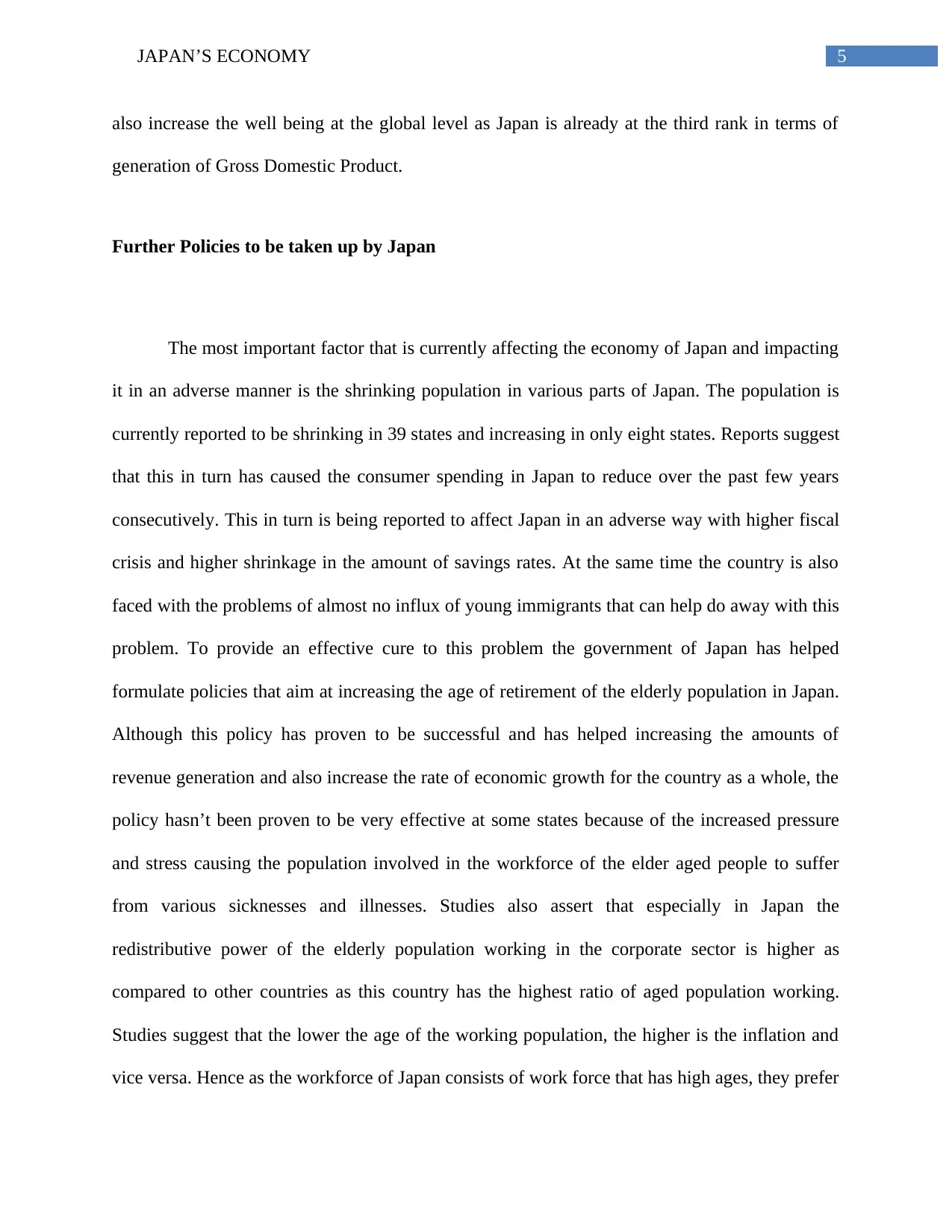
5JAPAN’S ECONOMY
also increase the well being at the global level as Japan is already at the third rank in terms of
generation of Gross Domestic Product.
Further Policies to be taken up by Japan
The most important factor that is currently affecting the economy of Japan and impacting
it in an adverse manner is the shrinking population in various parts of Japan. The population is
currently reported to be shrinking in 39 states and increasing in only eight states. Reports suggest
that this in turn has caused the consumer spending in Japan to reduce over the past few years
consecutively. This in turn is being reported to affect Japan in an adverse way with higher fiscal
crisis and higher shrinkage in the amount of savings rates. At the same time the country is also
faced with the problems of almost no influx of young immigrants that can help do away with this
problem. To provide an effective cure to this problem the government of Japan has helped
formulate policies that aim at increasing the age of retirement of the elderly population in Japan.
Although this policy has proven to be successful and has helped increasing the amounts of
revenue generation and also increase the rate of economic growth for the country as a whole, the
policy hasn’t been proven to be very effective at some states because of the increased pressure
and stress causing the population involved in the workforce of the elder aged people to suffer
from various sicknesses and illnesses. Studies also assert that especially in Japan the
redistributive power of the elderly population working in the corporate sector is higher as
compared to other countries as this country has the highest ratio of aged population working.
Studies suggest that the lower the age of the working population, the higher is the inflation and
vice versa. Hence as the workforce of Japan consists of work force that has high ages, they prefer
also increase the well being at the global level as Japan is already at the third rank in terms of
generation of Gross Domestic Product.
Further Policies to be taken up by Japan
The most important factor that is currently affecting the economy of Japan and impacting
it in an adverse manner is the shrinking population in various parts of Japan. The population is
currently reported to be shrinking in 39 states and increasing in only eight states. Reports suggest
that this in turn has caused the consumer spending in Japan to reduce over the past few years
consecutively. This in turn is being reported to affect Japan in an adverse way with higher fiscal
crisis and higher shrinkage in the amount of savings rates. At the same time the country is also
faced with the problems of almost no influx of young immigrants that can help do away with this
problem. To provide an effective cure to this problem the government of Japan has helped
formulate policies that aim at increasing the age of retirement of the elderly population in Japan.
Although this policy has proven to be successful and has helped increasing the amounts of
revenue generation and also increase the rate of economic growth for the country as a whole, the
policy hasn’t been proven to be very effective at some states because of the increased pressure
and stress causing the population involved in the workforce of the elder aged people to suffer
from various sicknesses and illnesses. Studies also assert that especially in Japan the
redistributive power of the elderly population working in the corporate sector is higher as
compared to other countries as this country has the highest ratio of aged population working.
Studies suggest that the lower the age of the working population, the higher is the inflation and
vice versa. Hence as the workforce of Japan consists of work force that has high ages, they prefer
⊘ This is a preview!⊘
Do you want full access?
Subscribe today to unlock all pages.

Trusted by 1+ million students worldwide
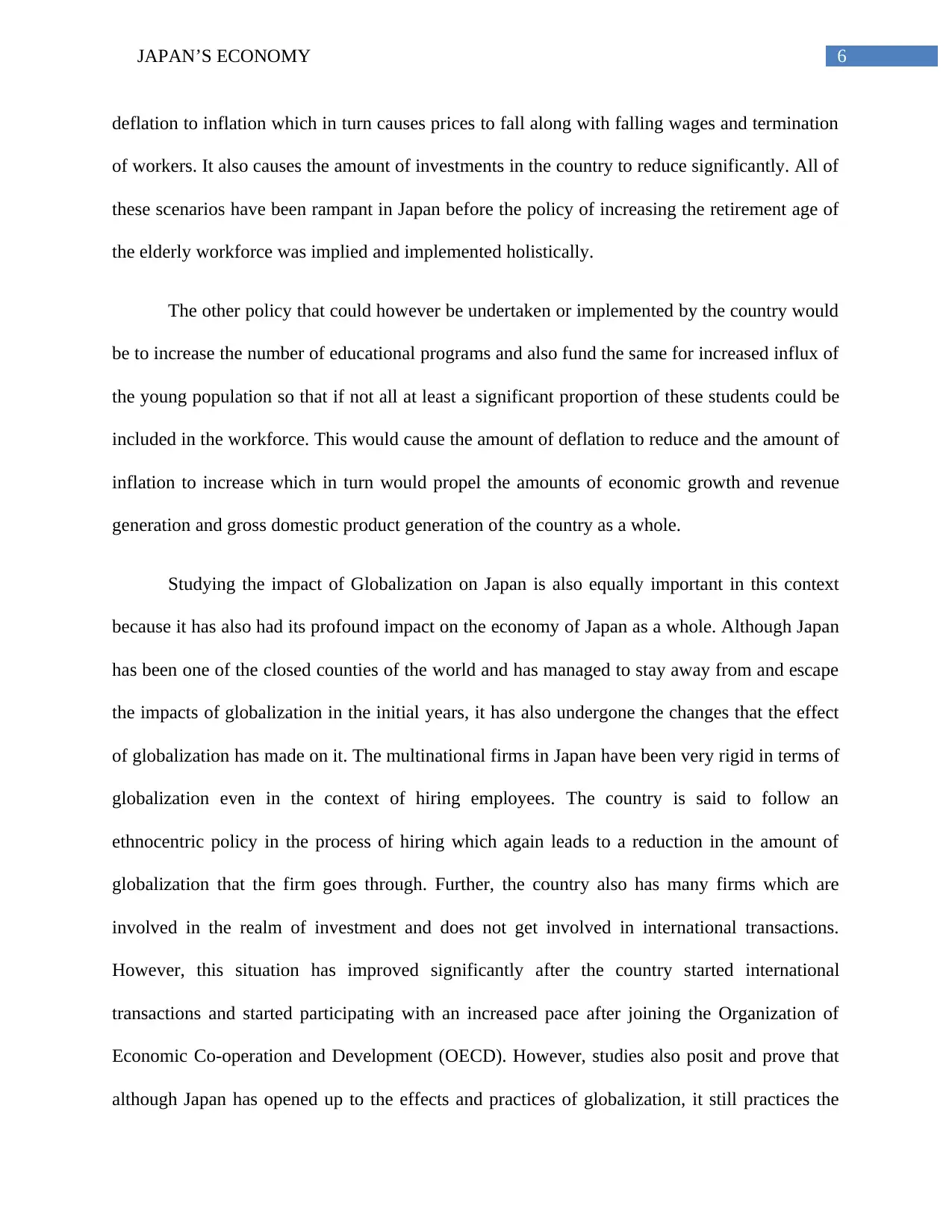
6JAPAN’S ECONOMY
deflation to inflation which in turn causes prices to fall along with falling wages and termination
of workers. It also causes the amount of investments in the country to reduce significantly. All of
these scenarios have been rampant in Japan before the policy of increasing the retirement age of
the elderly workforce was implied and implemented holistically.
The other policy that could however be undertaken or implemented by the country would
be to increase the number of educational programs and also fund the same for increased influx of
the young population so that if not all at least a significant proportion of these students could be
included in the workforce. This would cause the amount of deflation to reduce and the amount of
inflation to increase which in turn would propel the amounts of economic growth and revenue
generation and gross domestic product generation of the country as a whole.
Studying the impact of Globalization on Japan is also equally important in this context
because it has also had its profound impact on the economy of Japan as a whole. Although Japan
has been one of the closed counties of the world and has managed to stay away from and escape
the impacts of globalization in the initial years, it has also undergone the changes that the effect
of globalization has made on it. The multinational firms in Japan have been very rigid in terms of
globalization even in the context of hiring employees. The country is said to follow an
ethnocentric policy in the process of hiring which again leads to a reduction in the amount of
globalization that the firm goes through. Further, the country also has many firms which are
involved in the realm of investment and does not get involved in international transactions.
However, this situation has improved significantly after the country started international
transactions and started participating with an increased pace after joining the Organization of
Economic Co-operation and Development (OECD). However, studies also posit and prove that
although Japan has opened up to the effects and practices of globalization, it still practices the
deflation to inflation which in turn causes prices to fall along with falling wages and termination
of workers. It also causes the amount of investments in the country to reduce significantly. All of
these scenarios have been rampant in Japan before the policy of increasing the retirement age of
the elderly workforce was implied and implemented holistically.
The other policy that could however be undertaken or implemented by the country would
be to increase the number of educational programs and also fund the same for increased influx of
the young population so that if not all at least a significant proportion of these students could be
included in the workforce. This would cause the amount of deflation to reduce and the amount of
inflation to increase which in turn would propel the amounts of economic growth and revenue
generation and gross domestic product generation of the country as a whole.
Studying the impact of Globalization on Japan is also equally important in this context
because it has also had its profound impact on the economy of Japan as a whole. Although Japan
has been one of the closed counties of the world and has managed to stay away from and escape
the impacts of globalization in the initial years, it has also undergone the changes that the effect
of globalization has made on it. The multinational firms in Japan have been very rigid in terms of
globalization even in the context of hiring employees. The country is said to follow an
ethnocentric policy in the process of hiring which again leads to a reduction in the amount of
globalization that the firm goes through. Further, the country also has many firms which are
involved in the realm of investment and does not get involved in international transactions.
However, this situation has improved significantly after the country started international
transactions and started participating with an increased pace after joining the Organization of
Economic Co-operation and Development (OECD). However, studies also posit and prove that
although Japan has opened up to the effects and practices of globalization, it still practices the
Paraphrase This Document
Need a fresh take? Get an instant paraphrase of this document with our AI Paraphraser
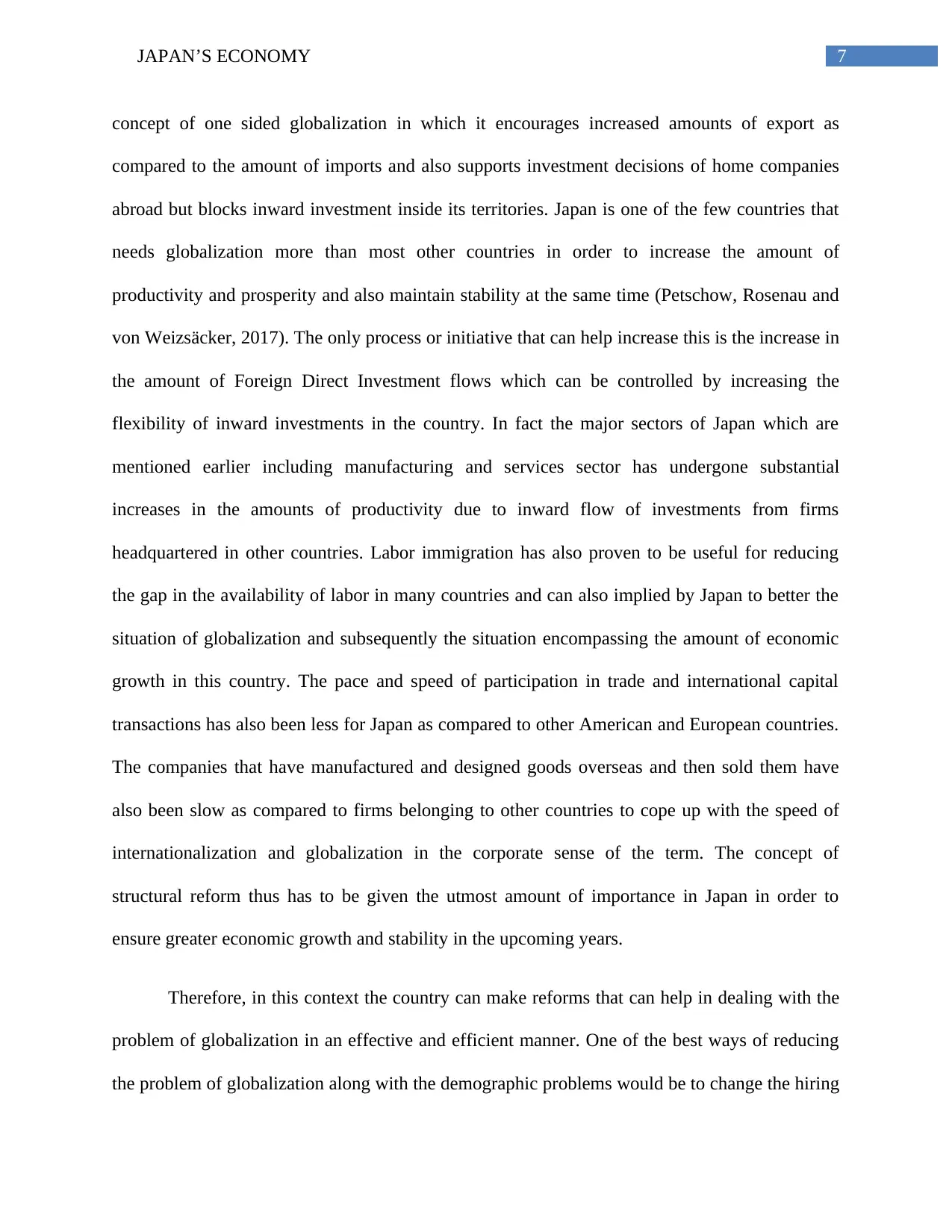
7JAPAN’S ECONOMY
concept of one sided globalization in which it encourages increased amounts of export as
compared to the amount of imports and also supports investment decisions of home companies
abroad but blocks inward investment inside its territories. Japan is one of the few countries that
needs globalization more than most other countries in order to increase the amount of
productivity and prosperity and also maintain stability at the same time (Petschow, Rosenau and
von Weizsäcker, 2017). The only process or initiative that can help increase this is the increase in
the amount of Foreign Direct Investment flows which can be controlled by increasing the
flexibility of inward investments in the country. In fact the major sectors of Japan which are
mentioned earlier including manufacturing and services sector has undergone substantial
increases in the amounts of productivity due to inward flow of investments from firms
headquartered in other countries. Labor immigration has also proven to be useful for reducing
the gap in the availability of labor in many countries and can also implied by Japan to better the
situation of globalization and subsequently the situation encompassing the amount of economic
growth in this country. The pace and speed of participation in trade and international capital
transactions has also been less for Japan as compared to other American and European countries.
The companies that have manufactured and designed goods overseas and then sold them have
also been slow as compared to firms belonging to other countries to cope up with the speed of
internationalization and globalization in the corporate sense of the term. The concept of
structural reform thus has to be given the utmost amount of importance in Japan in order to
ensure greater economic growth and stability in the upcoming years.
Therefore, in this context the country can make reforms that can help in dealing with the
problem of globalization in an effective and efficient manner. One of the best ways of reducing
the problem of globalization along with the demographic problems would be to change the hiring
concept of one sided globalization in which it encourages increased amounts of export as
compared to the amount of imports and also supports investment decisions of home companies
abroad but blocks inward investment inside its territories. Japan is one of the few countries that
needs globalization more than most other countries in order to increase the amount of
productivity and prosperity and also maintain stability at the same time (Petschow, Rosenau and
von Weizsäcker, 2017). The only process or initiative that can help increase this is the increase in
the amount of Foreign Direct Investment flows which can be controlled by increasing the
flexibility of inward investments in the country. In fact the major sectors of Japan which are
mentioned earlier including manufacturing and services sector has undergone substantial
increases in the amounts of productivity due to inward flow of investments from firms
headquartered in other countries. Labor immigration has also proven to be useful for reducing
the gap in the availability of labor in many countries and can also implied by Japan to better the
situation of globalization and subsequently the situation encompassing the amount of economic
growth in this country. The pace and speed of participation in trade and international capital
transactions has also been less for Japan as compared to other American and European countries.
The companies that have manufactured and designed goods overseas and then sold them have
also been slow as compared to firms belonging to other countries to cope up with the speed of
internationalization and globalization in the corporate sense of the term. The concept of
structural reform thus has to be given the utmost amount of importance in Japan in order to
ensure greater economic growth and stability in the upcoming years.
Therefore, in this context the country can make reforms that can help in dealing with the
problem of globalization in an effective and efficient manner. One of the best ways of reducing
the problem of globalization along with the demographic problems would be to change the hiring
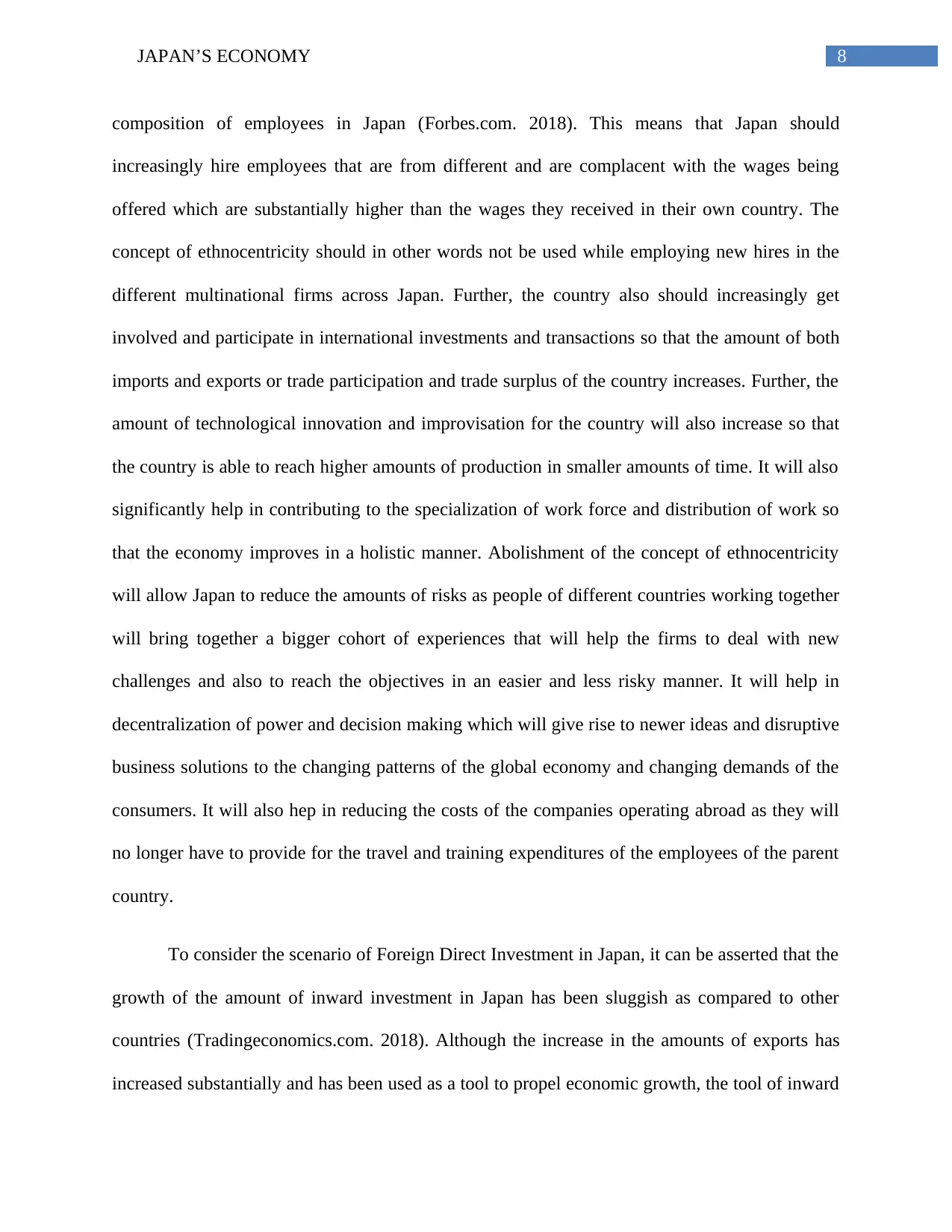
8JAPAN’S ECONOMY
composition of employees in Japan (Forbes.com. 2018). This means that Japan should
increasingly hire employees that are from different and are complacent with the wages being
offered which are substantially higher than the wages they received in their own country. The
concept of ethnocentricity should in other words not be used while employing new hires in the
different multinational firms across Japan. Further, the country also should increasingly get
involved and participate in international investments and transactions so that the amount of both
imports and exports or trade participation and trade surplus of the country increases. Further, the
amount of technological innovation and improvisation for the country will also increase so that
the country is able to reach higher amounts of production in smaller amounts of time. It will also
significantly help in contributing to the specialization of work force and distribution of work so
that the economy improves in a holistic manner. Abolishment of the concept of ethnocentricity
will allow Japan to reduce the amounts of risks as people of different countries working together
will bring together a bigger cohort of experiences that will help the firms to deal with new
challenges and also to reach the objectives in an easier and less risky manner. It will help in
decentralization of power and decision making which will give rise to newer ideas and disruptive
business solutions to the changing patterns of the global economy and changing demands of the
consumers. It will also hep in reducing the costs of the companies operating abroad as they will
no longer have to provide for the travel and training expenditures of the employees of the parent
country.
To consider the scenario of Foreign Direct Investment in Japan, it can be asserted that the
growth of the amount of inward investment in Japan has been sluggish as compared to other
countries (Tradingeconomics.com. 2018). Although the increase in the amounts of exports has
increased substantially and has been used as a tool to propel economic growth, the tool of inward
composition of employees in Japan (Forbes.com. 2018). This means that Japan should
increasingly hire employees that are from different and are complacent with the wages being
offered which are substantially higher than the wages they received in their own country. The
concept of ethnocentricity should in other words not be used while employing new hires in the
different multinational firms across Japan. Further, the country also should increasingly get
involved and participate in international investments and transactions so that the amount of both
imports and exports or trade participation and trade surplus of the country increases. Further, the
amount of technological innovation and improvisation for the country will also increase so that
the country is able to reach higher amounts of production in smaller amounts of time. It will also
significantly help in contributing to the specialization of work force and distribution of work so
that the economy improves in a holistic manner. Abolishment of the concept of ethnocentricity
will allow Japan to reduce the amounts of risks as people of different countries working together
will bring together a bigger cohort of experiences that will help the firms to deal with new
challenges and also to reach the objectives in an easier and less risky manner. It will help in
decentralization of power and decision making which will give rise to newer ideas and disruptive
business solutions to the changing patterns of the global economy and changing demands of the
consumers. It will also hep in reducing the costs of the companies operating abroad as they will
no longer have to provide for the travel and training expenditures of the employees of the parent
country.
To consider the scenario of Foreign Direct Investment in Japan, it can be asserted that the
growth of the amount of inward investment in Japan has been sluggish as compared to other
countries (Tradingeconomics.com. 2018). Although the increase in the amounts of exports has
increased substantially and has been used as a tool to propel economic growth, the tool of inward
⊘ This is a preview!⊘
Do you want full access?
Subscribe today to unlock all pages.

Trusted by 1+ million students worldwide
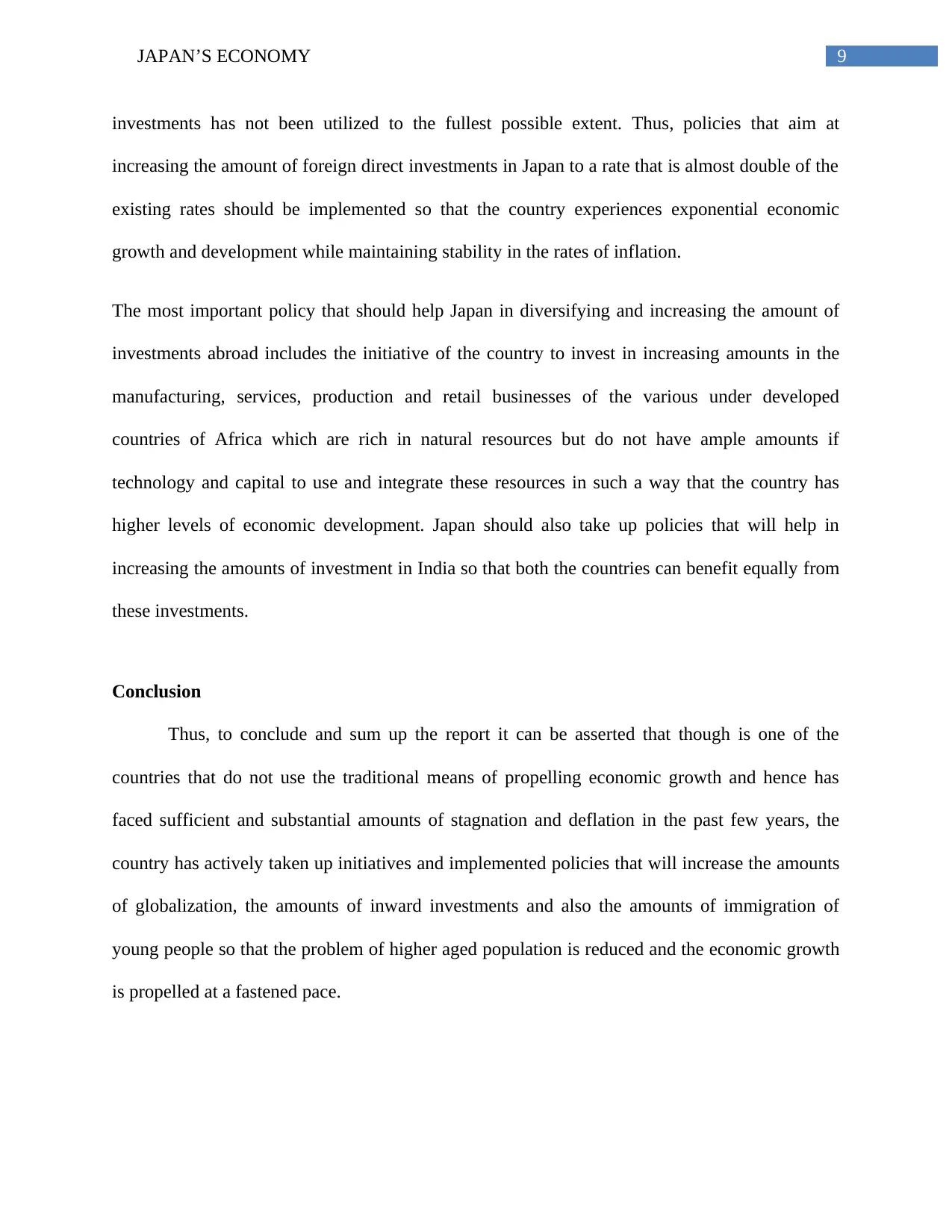
9JAPAN’S ECONOMY
investments has not been utilized to the fullest possible extent. Thus, policies that aim at
increasing the amount of foreign direct investments in Japan to a rate that is almost double of the
existing rates should be implemented so that the country experiences exponential economic
growth and development while maintaining stability in the rates of inflation.
The most important policy that should help Japan in diversifying and increasing the amount of
investments abroad includes the initiative of the country to invest in increasing amounts in the
manufacturing, services, production and retail businesses of the various under developed
countries of Africa which are rich in natural resources but do not have ample amounts if
technology and capital to use and integrate these resources in such a way that the country has
higher levels of economic development. Japan should also take up policies that will help in
increasing the amounts of investment in India so that both the countries can benefit equally from
these investments.
Conclusion
Thus, to conclude and sum up the report it can be asserted that though is one of the
countries that do not use the traditional means of propelling economic growth and hence has
faced sufficient and substantial amounts of stagnation and deflation in the past few years, the
country has actively taken up initiatives and implemented policies that will increase the amounts
of globalization, the amounts of inward investments and also the amounts of immigration of
young people so that the problem of higher aged population is reduced and the economic growth
is propelled at a fastened pace.
investments has not been utilized to the fullest possible extent. Thus, policies that aim at
increasing the amount of foreign direct investments in Japan to a rate that is almost double of the
existing rates should be implemented so that the country experiences exponential economic
growth and development while maintaining stability in the rates of inflation.
The most important policy that should help Japan in diversifying and increasing the amount of
investments abroad includes the initiative of the country to invest in increasing amounts in the
manufacturing, services, production and retail businesses of the various under developed
countries of Africa which are rich in natural resources but do not have ample amounts if
technology and capital to use and integrate these resources in such a way that the country has
higher levels of economic development. Japan should also take up policies that will help in
increasing the amounts of investment in India so that both the countries can benefit equally from
these investments.
Conclusion
Thus, to conclude and sum up the report it can be asserted that though is one of the
countries that do not use the traditional means of propelling economic growth and hence has
faced sufficient and substantial amounts of stagnation and deflation in the past few years, the
country has actively taken up initiatives and implemented policies that will increase the amounts
of globalization, the amounts of inward investments and also the amounts of immigration of
young people so that the problem of higher aged population is reduced and the economic growth
is propelled at a fastened pace.
Paraphrase This Document
Need a fresh take? Get an instant paraphrase of this document with our AI Paraphraser
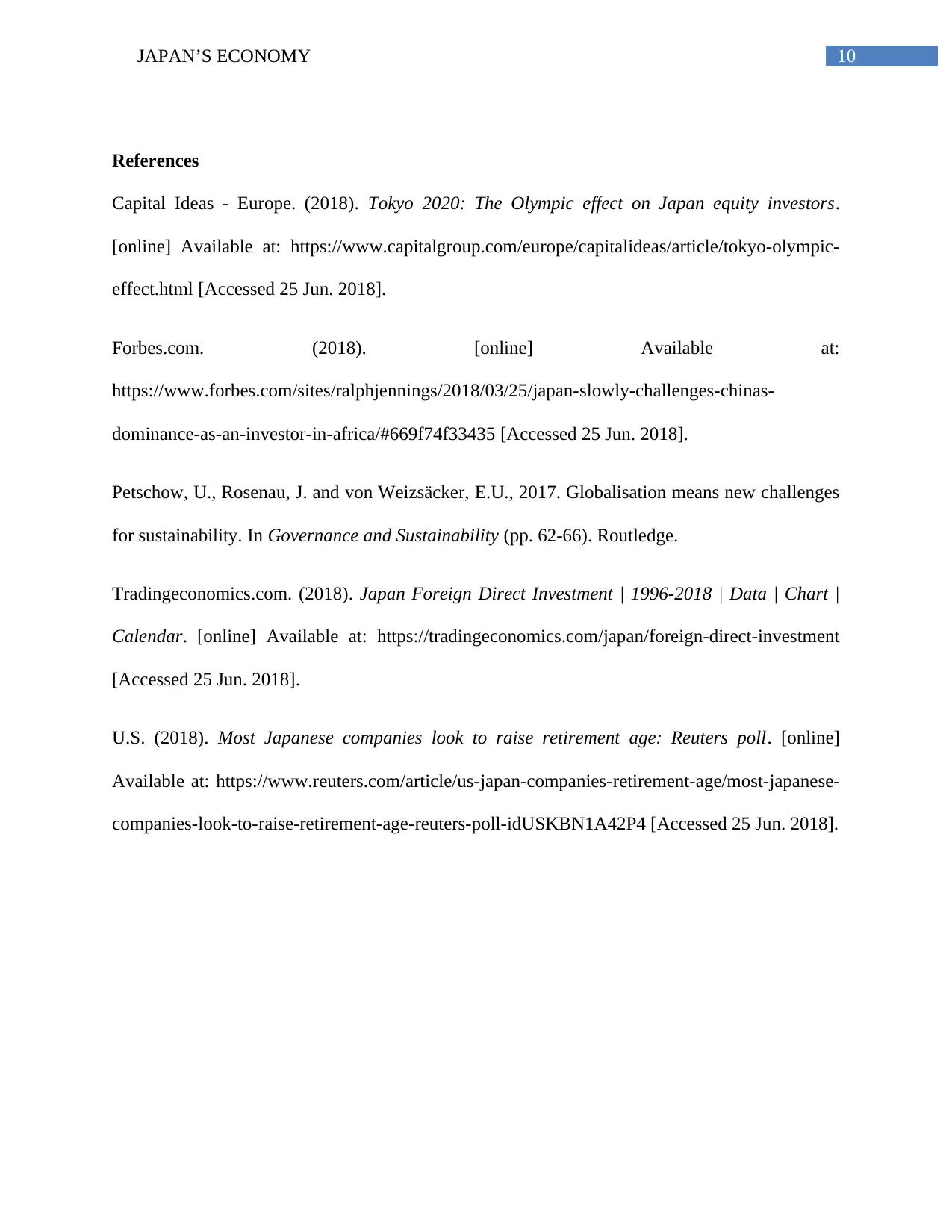
10JAPAN’S ECONOMY
References
Capital Ideas - Europe. (2018). Tokyo 2020: The Olympic effect on Japan equity investors.
[online] Available at: https://www.capitalgroup.com/europe/capitalideas/article/tokyo-olympic-
effect.html [Accessed 25 Jun. 2018].
Forbes.com. (2018). [online] Available at:
https://www.forbes.com/sites/ralphjennings/2018/03/25/japan-slowly-challenges-chinas-
dominance-as-an-investor-in-africa/#669f74f33435 [Accessed 25 Jun. 2018].
Petschow, U., Rosenau, J. and von Weizsäcker, E.U., 2017. Globalisation means new challenges
for sustainability. In Governance and Sustainability (pp. 62-66). Routledge.
Tradingeconomics.com. (2018). Japan Foreign Direct Investment | 1996-2018 | Data | Chart |
Calendar. [online] Available at: https://tradingeconomics.com/japan/foreign-direct-investment
[Accessed 25 Jun. 2018].
U.S. (2018). Most Japanese companies look to raise retirement age: Reuters poll. [online]
Available at: https://www.reuters.com/article/us-japan-companies-retirement-age/most-japanese-
companies-look-to-raise-retirement-age-reuters-poll-idUSKBN1A42P4 [Accessed 25 Jun. 2018].
References
Capital Ideas - Europe. (2018). Tokyo 2020: The Olympic effect on Japan equity investors.
[online] Available at: https://www.capitalgroup.com/europe/capitalideas/article/tokyo-olympic-
effect.html [Accessed 25 Jun. 2018].
Forbes.com. (2018). [online] Available at:
https://www.forbes.com/sites/ralphjennings/2018/03/25/japan-slowly-challenges-chinas-
dominance-as-an-investor-in-africa/#669f74f33435 [Accessed 25 Jun. 2018].
Petschow, U., Rosenau, J. and von Weizsäcker, E.U., 2017. Globalisation means new challenges
for sustainability. In Governance and Sustainability (pp. 62-66). Routledge.
Tradingeconomics.com. (2018). Japan Foreign Direct Investment | 1996-2018 | Data | Chart |
Calendar. [online] Available at: https://tradingeconomics.com/japan/foreign-direct-investment
[Accessed 25 Jun. 2018].
U.S. (2018). Most Japanese companies look to raise retirement age: Reuters poll. [online]
Available at: https://www.reuters.com/article/us-japan-companies-retirement-age/most-japanese-
companies-look-to-raise-retirement-age-reuters-poll-idUSKBN1A42P4 [Accessed 25 Jun. 2018].
1 out of 11
Related Documents
Your All-in-One AI-Powered Toolkit for Academic Success.
+13062052269
info@desklib.com
Available 24*7 on WhatsApp / Email
![[object Object]](/_next/static/media/star-bottom.7253800d.svg)
Unlock your academic potential
Copyright © 2020–2025 A2Z Services. All Rights Reserved. Developed and managed by ZUCOL.





